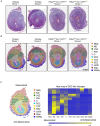Spatial transcriptomic profiles of mouse uterine microenvironments at pregnancy day 7.5†
- PMID: 35357464
- PMCID: PMC9382390
- DOI: 10.1093/biolre/ioac061
Spatial transcriptomic profiles of mouse uterine microenvironments at pregnancy day 7.5†
Abstract
Uterine dysfunctions lead to fertility disorders and pregnancy complications. Normal uterine functions at pregnancy depend on crosstalk among multiple cell types in uterine microenvironments. Here, we performed the spatial transcriptomics and single-cell RNA-seq assays to determine local gene expression profiles at the embryo implantation site of the mouse uterus on pregnancy day 7.5 (D7.5). The spatial transcriptomic annotation identified 11 domains of distinct gene signatures, including a mesometrial myometrium, an anti-mesometrial myometrium, a mesometrial decidua enriched with natural killer cells, a vascular sinus zone for maternal vessel remodeling, a fetal-maternal interface, a primary decidual zone, a transition decidual zone, a secondary decidual zone, undifferentiated stroma, uterine glands, and the embryo. The scRNA-Seq identified 12 types of cells in the D7.5 uterus including three types of stromal fibroblasts with differentiated and undifferentiated markers, one cluster of epithelium including luminal and glandular epithelium, mesothelium, endothelia, pericytes, myelomonocytic cell, natural killer cells, and lymphocyte B. These single-cell RNA signatures were then utilized to deconvolute the cell-type compositions of each individual uterine microenvironment. Functional annotation assays on spatial transcriptomic data revealed uterine microenvironments with distinguished metabolic preferences, immune responses, and various cellular behaviors that are regulated by region-specific endocrine and paracrine signals. Global interactome among regions is also projected based on the spatial transcriptomic data. This study provides high-resolution transcriptome profiles with locality information at the embryo implantation site to facilitate further investigations on molecular mechanisms for normal pregnancy progression.
Keywords: decidua; microenvironment; postimplantation; scRNA-Seq; spatial transcriptomics; uterus.
Published by Oxford University Press on behalf of Society for the Study of Reproduction 2022.
Figures







Similar articles
-
Differential uterine expression of estrogen and progesterone receptors correlates with uterine preparation for implantation and decidualization in the mouse.Endocrinology. 1999 Nov;140(11):5310-21. doi: 10.1210/endo.140.11.7148. Endocrinology. 1999. PMID: 10537162 Free PMC article.
-
Investigation of the pregnancy-induced muscle bundle dispersal of the inner myometrium of adult mouse uterus and its relationship to the metrial gland/MLAp.Biochem Biophys Res Commun. 2021 Dec 20;584:66-72. doi: 10.1016/j.bbrc.2021.11.007. Epub 2021 Nov 5. Biochem Biophys Res Commun. 2021. PMID: 34768084
-
Expression of matrix metalloproteinases and tissue inhibitors of metalloproteinases in the mouse uterus during the peri-implantation period.Dev Genet. 1997;21(1):44-54. doi: 10.1002/(SICI)1520-6408(1997)21:1<44::AID-DVG5>3.0.CO;2-8. Dev Genet. 1997. PMID: 9291579
-
The decidua-the maternal bed embracing the embryo-maintains the pregnancy.Semin Immunopathol. 2016 Nov;38(6):635-649. doi: 10.1007/s00281-016-0574-0. Epub 2016 Jun 10. Semin Immunopathol. 2016. PMID: 27287066 Free PMC article. Review.
-
Leukocyte driven-decidual angiogenesis in early pregnancy.Cell Mol Immunol. 2014 Nov;11(6):522-37. doi: 10.1038/cmi.2014.63. Epub 2014 Jul 28. Cell Mol Immunol. 2014. PMID: 25066422 Free PMC article. Review.
Cited by
-
PR-SET7 epigenetically restrains uterine interferon response and cell death governing proper postnatal stromal development.Nat Commun. 2024 Jun 10;15(1):4920. doi: 10.1038/s41467-024-49342-6. Nat Commun. 2024. PMID: 38858353 Free PMC article.
-
Cell type and cell signalling innovations underlying mammalian pregnancy.Nat Ecol Evol. 2025 Aug;9(8):1469-1486. doi: 10.1038/s41559-025-02748-x. Epub 2025 Jul 1. Nat Ecol Evol. 2025. PMID: 40596730 Free PMC article.
-
ATOH8 Expression Is Regulated by BMP2 and Plays a Key Role in Human Endometrial Stromal Cell Decidualization.Endocrinology. 2023 Nov 20;165(1):bqad188. doi: 10.1210/endocr/bqad188. Endocrinology. 2023. PMID: 38060684 Free PMC article.
-
An ex vivo uterine system captures implantation, embryogenesis, and trophoblast invasion via maternal-embryonic signaling.Nat Commun. 2025 Jul 1;16(1):5755. doi: 10.1038/s41467-025-60610-x. Nat Commun. 2025. PMID: 40595542 Free PMC article.
-
Signaling via retinoic acid receptors mediates decidual angiogenesis in mice and human stromal cell decidualization.FASEB J. 2025 Jan 15;39(1):e70291. doi: 10.1096/fj.202400766R. FASEB J. 2025. PMID: 39777800 Free PMC article.
References
-
- Farquhar CM, Bhattacharya S, Repping S, Mastenbroek S, Kamath MS, Marjoribanks J, Boivin J. Female subfertility. Nat Rev Dis Primers 2019; 5:7. - PubMed
-
- Law A, McCoy M, Lynen R, Curkendall SM, Gatwood J, Juneau PL, Landsman-Blumberg P. The prevalence of complications and healthcare costs during pregnancy. J Med Econ 2015; 18:533–541. - PubMed
-
- Tamaya T, Fujimoto J, Arabori K, Wada K, Kato Y, Okada H. The biologic role of sex steroid receptors in the decidualization of human endometrium. Asia Oceania J Obstet Gynaecol 1985; 11:573–578. - PubMed
-
- Dunk C, Kwan M, Hazan A, Walker S, Wright JK, Harris LK, Jones RL, Keating S, Kingdom JCP, Whittle W, Maxwell C and Lye SJ. Failure of decidualization and maternal immune tolerance underlies uterovascular resistance in intra uterine growth restriction. Front Endocrinol (Lausanne) 2019; 10:160. - PMC - PubMed
Publication types
MeSH terms
Grants and funding
LinkOut - more resources
Full Text Sources
Molecular Biology Databases

